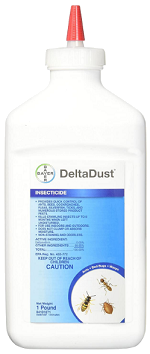Table of Contents:
How Do You Get Rid of a Yellowjacket Ground Nest?
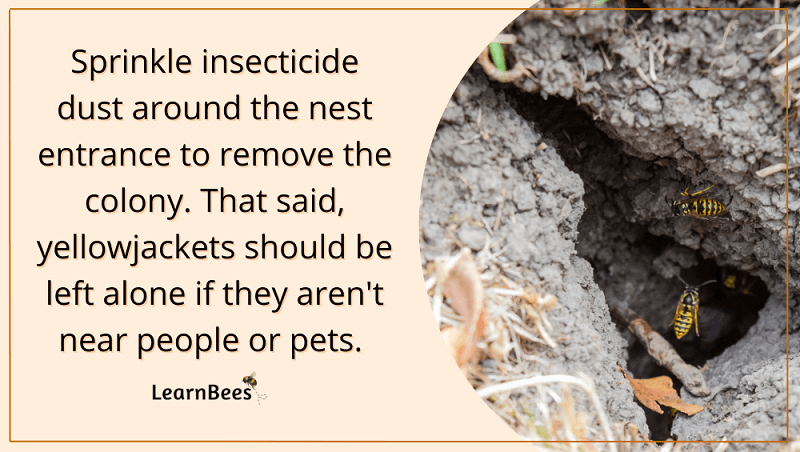
The best way to eliminate yellowjacket nests is to use insecticide dust.
Sprinkle the insecticide dust around the nest entrance so the yellowjackets will walk through it. The insecticide dust will poison them once they clean themselves and ingest it. The entire yellowjacket colony should die after two or three days.
However, you should only remove a yellowjacket nest if:
- The nest is too close to people or pets
- You’re a beekeeper, and the nest is close to your honey bees
- The nest is unavoidable
Yellowjackets are important pollinators that also help control pest populations. They eat flies, mosquitoes, and beetles. Without yellowjackets, our world would be overrun with pests.
Better yet?
Farmers are increasingly turning to yellowjackets to protect their crops from bugs like aphids, cabbage worms, and crickets.
Still, it may be necessary to remove a yellowjacket nest if it’s too close to people or pets. Hiring a pest control company is the safest way to remove their nest. But follow these tips if you plan on doing it yourself:
Tip 1: Wait Until Dark to Remove the Yellowjacket Nest
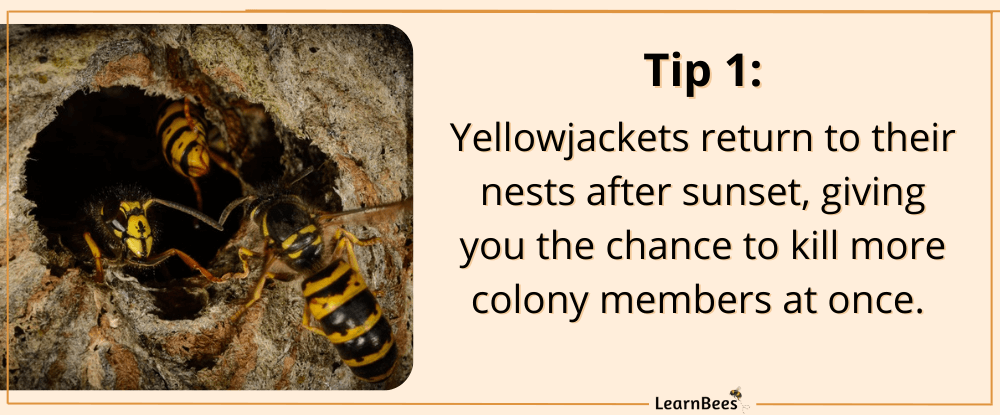
Yellowjackets are diurnal, which means they’re the most active during the day. At night, they return to their nests until the sun rises again.
Using the insecticide dust at night (or just before dark) increases your chances of killing the entire colony.
Additionally, the yellowjackets are less active once nightfall hits. This allows you to get close enough to their nest when they’re least defensive.
Tip 2: Wear Protective Clothing
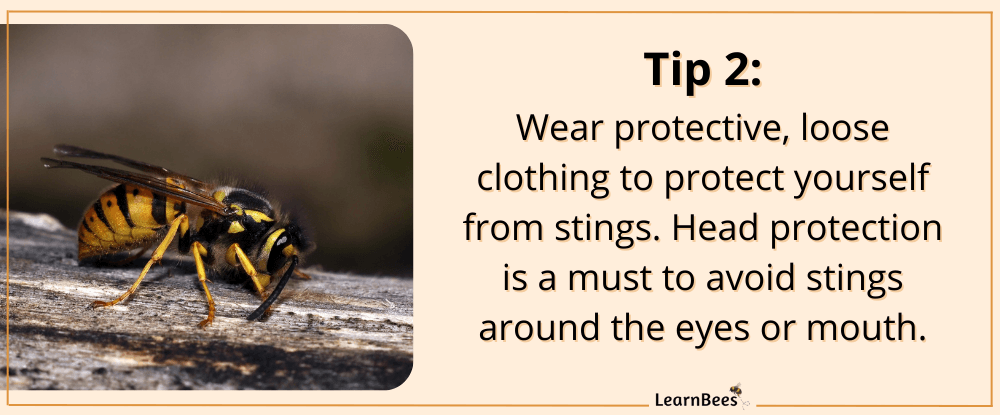
Yellowjackets live in large colonies with hundreds or even thousands of other wasps. When threatened, they release alarm pheromones that signal danger to the other colony members.
Protective clothing is important to prevent getting stung by multiple yellowjackets.
We recommend wearing a head covering and thick gloves at a bare minimum. Getting stung on the face or hands isn’t fun.
You should also wear the following:
- Long-sleeves (loose fitting)
- Jeans (loose fitting)
- Close-toed shoes
If you have long hair, it’s best to tie it up to reduce the chances that a wasp gets stuck in it.
Tip 3: Use an Insecticide Dust
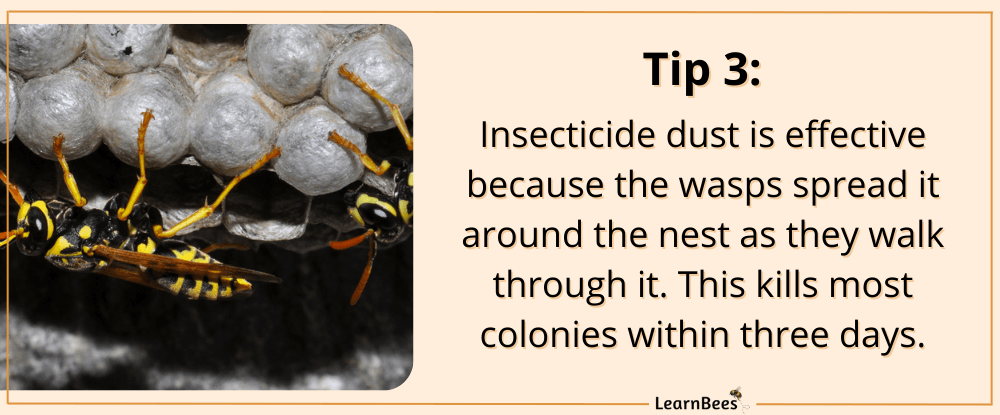
Insecticide dust is more effective and safe than other DIY methods.
Other DIY methods – like soapy water – requires you to spray inside the nest. This disturbs the colony and can result in multiple yellowjacket stings.
Also, spray methods aren’t always effective for killing the entire colony.
Why?
Because yellowjacket nests can be pretty deep, making it hard to reach the whole thing when spraying. For example, you may not reach the nest if it’s tucked inside a corner underground.
Insecticide dust works well because the yellowjackets spread it around the nest as they walk through it. It typically kills off the colony in two or three days.
For large yellowjacket colonies:
You may have to sprinkle the dust nightly for two or three days to ensure you get them all.
How Many Yellowjackets Are in a Ground Nest?
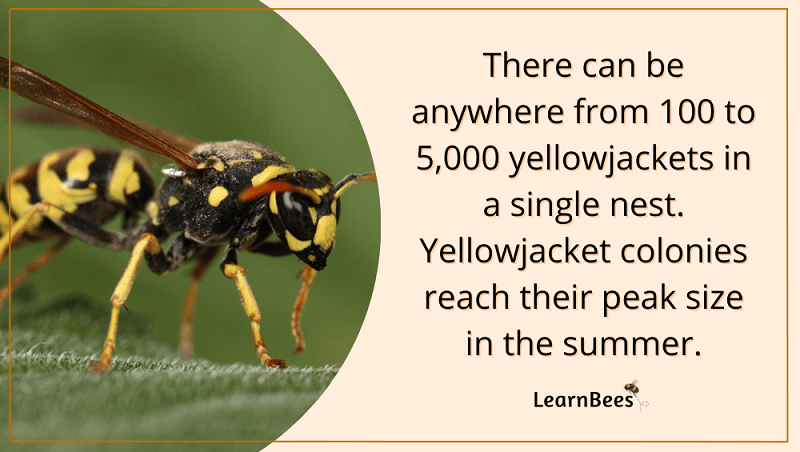
There can typically be anywhere from 100 to 5,000 yellowjackets in a ground nest.
The size of the yellowjacket nest depends on the time of year, colony health, and food sources in your area.
The yellowjacket colony reaches its peak in the summer. As late fall approaches, the yellowjacket workers slowly die off until the nest is abandoned completely. Only the queen yellowjackets are left behind to hibernate until spring.
If possible, removing a yellowjacket nest is best once it’s abandoned by late fall. You can cover the hole to prevent a new colony from returning in the spring.
Yellowjacket colonies can remain active in warm climates such as South Florida or California.
For example, it’s not unusual to see wasps flying around in December or January in temperate areas. Wasps are active when temperatures are consistently above 50°F (10 °C).
Where Do Yellowjackets Nest in the Ground?
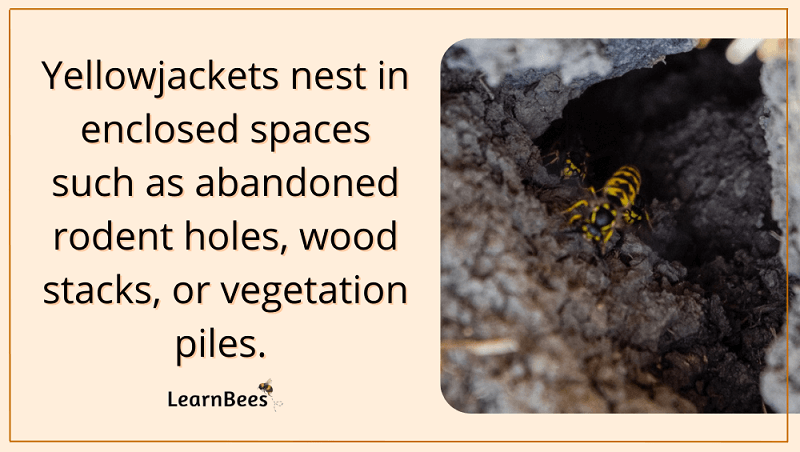
Yellowjackets don’t dig their own nests. Instead, they search for empty rodent holes, vegetation piles, wood stacks, or other enclosed spaces.
A yellowjacket nest can be hard to spot at first glance because the nest entrance is usually small. The best time to identify their nest is after the day warms up on a sunny day. Typically, the wasps are the most active between 12 pm and 4 pm.
Look for areas where you see yellowjackets flying around. This indicates their nest may be close by. A cluster of yellowjackets will typically sit at the nest entrance to guard it.
Remember:
Be careful about getting too close to a yellowjacket nest – especially when they’re most active during the day.
If you’re seriously allergic to insect stings, contacting a pest control company is best for removing their nest.
FAQs on Yellowjacket Ground Nests
- Do yellowjackets nest in the wall?
- How do I get rid of a yellowjacket ground nest in the winter?
- Do you need to remove a yellowjacket nest in the ground?
- What happens if you spray a yellowjacket nest?
- Do yellowjacket nests have two entrances?
- Can you plug a yellowjacket nest in the ground?
- What time of day do you get rid of yellowjacket nests?
- Do yellowjackets return to the same ground nest every year?
- Where do yellowjackets go if you destroy their nest?
- How long do yellowjackets stay in the ground?
- Can I pour gas in a yellowjacket nest?
- Do yellowjackets go in the ground at night?
- What does Dawn dish soap do to yellowjackets?
- Will WD-40 get rid of yellowjackets?
Do yellowjackets nest in the wall?
Yellowjackets can nest in walls or attics. However, they’re most likely to nest underground.
Honey bees are more commonly found inside walls or attics because they nest above ground. Honey bees and yellowjackets are commonly mistaken for each other because they have similar sizes and coloring.
Fortunately, yellowjacket and honey bee nests will not cause structural damage to homes.
For yellowjacket nest removal, you can wait until the yellowjackets abandon their nests in the late fall. Next, close entry holes to prevent a new colony from returning in the spring. This is the easiest and best way to get rid of their nest.
For immediate removal, you can try spraying soapy water inside the wall cavity. With that said, pest control companies are best equipt to handle yellowjacket nests inside the walls of your home.
You should contact a local beekeeper for help removing honey bees. Beekeepers will often remove honey bee nests for free.
—> Go back to the FAQs on yellowjacket ground nests
More to Explore:
How do I get rid of a yellowjacket ground nest in the winter?
Yellowjackets typically die off by the late fall, so most people don’t have to worry about dealing with winter yellowjacket nests.
However, if you live in a very mild climate, you may have wasps hanging around all year. In such cases, we recommend leaving the nest alone if it isn’t near people or pets. Yellowjackets are valuable insects that pollinate and kill pests.
We recommend using insecticide dust around the nest entrance if you need to remove them. Sprinkle the dust thoroughly around the hole and give it two to three days to wipe out the colony entirely.
If the colony isn’t dead after three days, sprinkle another application of dust around the nest entrance. Large yellowjacket colonies may require two or three applications of insecticide dust to obliterate their nest.
—> Go back to the FAQs on yellowjacket ground nests
More to Explore:
- What’s the Difference Between Wasps, Hornets, and Bees?
- Wasp Nest vs. Bee Nest: Which One Is It?
- Wasps vs. Honey Bees: Are They Different?
Do you need to remove a yellowjacket nest in the ground?
You don’t need to remove a yellowjacket nest unless it’s too close to people or pets. To be safe, it’s best to have at least 50 feet of distance between humans and yellowjacket nests.
—> Go back to the FAQs on yellowjacket ground nests
More to Explore:
What happens if you spray a yellowjacket nest?
Yellowjackets will die if sprayed with wasp spray, soapy water, WD-40, or other popular home remedies.
Spraying the nest may not kill the entire colony, though. Yellowjacket nests can be deep, and sprays may not reach the corners of the nest. As such, sprays may only kill part of the colony. The surviving yellowjackets will work to rebuild the colony over several weeks or months.
—> Go back to the FAQs on yellowjacket ground nests
More to Explore:
Do yellowjacket nests have two entrances?
Yes, a yellowjacket nest can have two entrances.
—> Go back to the FAQs on yellowjacket ground nests
More to Explore:
Can you plug a yellowjacket nest in the ground?
Plugging a yellowjacket nest should only be done when the wasps have abandoned the nest by late fall. This prevents a new colony from nesting there next year.
Plugging a yellowjacket nest isn’t an effective means of removal. The yellowjackets can often find another entry and exit point. Instead, use insecticide dust to remove the nest.
—> Go back to the FAQs on yellowjacket ground nests
More to Explore:
What time of day do you get rid of yellowjacket nests?
It’s best to eliminate yellowjacket nests just before or after nightfall. This is when the wasps have returned to their nest for the evening and are less active.
—> Go back to the FAQs on yellowjacket ground nests
More to Explore:
Do yellowjackets return to the same ground nest every year?
Yellowjackets don’t always return to a nest each year, although it sometimes happens.
It’s important to note that yellowjacket workers die as the temperature drops in the fall. Queen yellowjackets hibernate until spring. The queen yellowjackets begin nesting and building a new colony as the weather warms up.
As such, it’s not the same yellowjacket colony that returns yearly.
—> Go back to the FAQs on yellowjacket ground nests
More to Explore:
Where do yellowjackets go if you destroy their nest?
Yellowjackets will typically find somewhere else to nest if they survive.
—> Go back to the FAQs on yellowjacket ground nests
More to Explore:
How long do yellowjackets stay in the ground?
Yellowjackets typically only stay in the ground during the warm months. As winter approaches, the colony slowly dies off one by one. Only the queen yellowjackets will survive, and they’ll hibernate until spring.
—> Go back to the FAQs on yellowjacket ground nests
More to Explore:
Can I pour gas in a yellowjacket nest?
Gas should not be used to kill yellowjackets because it’s a fire hazard. It also poisons the ground, killing both plants and animals.
—> Go back to the FAQs on yellowjacket ground nests
More to Explore:
Do yellowjackets go in the ground at night?
Yes, yellowjackets go back to their ground nests at night.
—> Go back to the FAQs on yellowjacket ground nests
What does Dawn dish soap do to yellowjackets?
Dish soap clogs the yellowjackets spiracles, which is what they use to breathe through. In turn, this essentially suffocates them.
—> Go back to the FAQs on yellowjacket ground nests
Will WD-40 get rid of yellowjackets?
WD-40 will kill yellowjackets. However, it may not kill the entire colony if the nest is too deep to reach or if it’s tucked behind a corner in the ground.
People often ask, “How do you get rid of an underground yellowjacket nest?”
We recommend using insecticide dust. It’s the safest and most effective way to remove yellowjackets because they spread it around their nest as they walk through the dust.
Insecticide dust also doesn’t disturb the nest in the same way that spraying chemicals does. When you spray chemicals, you send the yellowjackets into a panic which can lead to stings.





